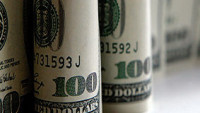 It was all about the Federal Reserve yesterday on currency and bond markets with the US dollar index moving back to levels last seen in 2003, putting downward pressure on every single G10 currency, with the euro, the pound and the Japanese yen in particular sliding sharply as bond yield differentials widened out to multi year highs.
It was all about the Federal Reserve yesterday on currency and bond markets with the US dollar index moving back to levels last seen in 2003, putting downward pressure on every single G10 currency, with the euro, the pound and the Japanese yen in particular sliding sharply as bond yield differentials widened out to multi year highs.
The pound initially held up well to the US dollar onslaught but soon fell back in the wake of the Bank of England keeping rates on hold and suggesting that the recent rebound in sterling may well cause an undershoot in future inflation expectations. Sadly this very admission caused the pound to slip back and could well have the effect of lifting these expectations back up again.
Yesterday’s strong performance for European markets was helped in no small part by this very currency weakness as exporters got a boost with the DAX hitting its highest levels this year, and pushed the FTSE100 back above the 7,000 level for the first time since the end of October.
As for the DAX it’s hard to believe that up until ten days ago the German benchmark had never been in positive territory this year, and now it’s up 4.6%, having been down 18% at one point in February this year.
With the US dollar punching higher to levels last seen in 2002 against the euro the prospect of further gains, must at some point be a cause for concern for US companies who rely on exports, however US stock markets were able to pare back some of Wednesday’s losses yesterday, due to some more robust economic data from the manufacturing sector. Interestingly they were unable to overcome the highs seen prior to Wednesday’s FOMC announcement which means the Dow 20k mark will have to wait a little longer.
The policy divergence between the US central bank and other central banks is no better illustrated than against the euro, where earlier this month we heard ECB President Draghi announce the latest extension to the banks QE program. Later this morning we get to see the final numbers for EU CPI for November which are expected to be confirmed at 0.6%, with core prices at 0.8%.
No better is this policy chasm illustrated than the spread differential between US 10 year treasuries and the German bund which has reached levels last seen in 1989, the year the Berlin Wall came down. This is wider than when the euro hit its all-time low at 0.8230 in December 2000, which suggests that the euro could well have further to fall.
As we head into the weekend it’s been a good week overall for stock markets and another disappointing week for US bond markets, while gold has also suffered, sliding back to its lowest levels since early February, and on course to potentially wipe out most of its gains for this year.
One welcome side effect from the bond market sell-off is the fact that some of the concerns about rising pension deficits have receded a little, as yields have risen.
EURUSD – the euro has slid below the 1.0460 area and with it has opened up the risk of a move towards parity. To delay this prospect we would need to see a move back through the 1.0520 area and the lows this year.
GBPUSD – having failed to crack the 100 day MA at 1.2760 the pound has slipped below 1.2460 trend line support from the October lows, raising the prospect of a move towards 1.2300. Only a move through 1.2300 opens up the potential to revisit the recent lows near the 1.2100 area.
EURGBP – finding some support just above the 200 day MA at 0.8310, which remains a key support. We need to see a recovery back through 0.8480 to stabilise.
USDJPY – continues to drive higher towards the 120.00 level, and likely to continue to do so while above the 115.60 level. A move back below 115.60 would then suggest a move back towards 114.00.













